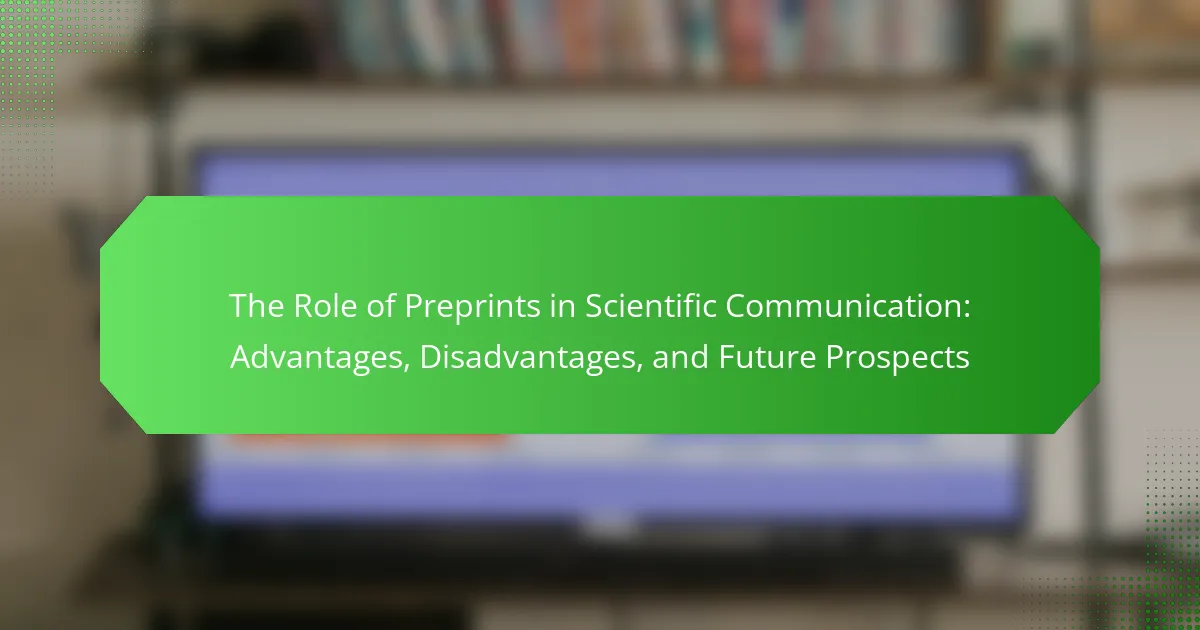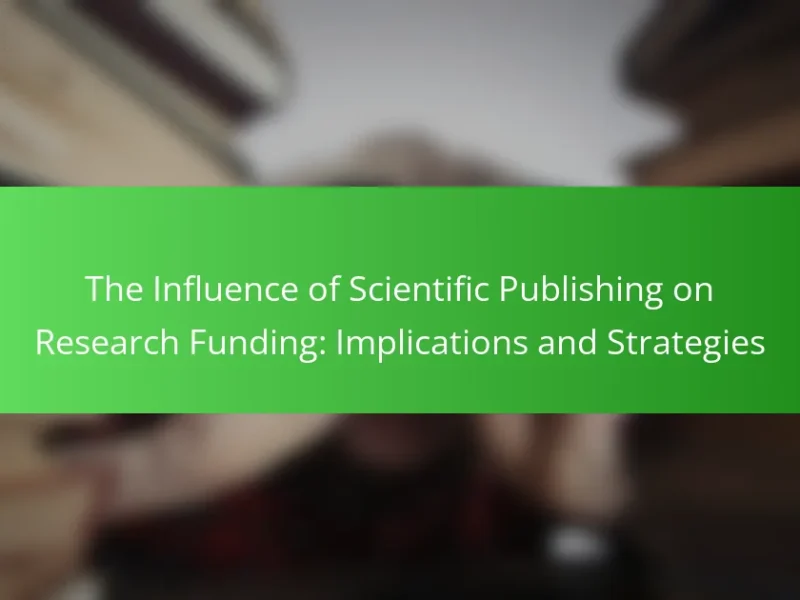Preprints are early versions of research papers made publicly available prior to peer review, facilitating quick dissemination of findings and immediate feedback from the scientific community. This process enhances collaboration among researchers and increases the visibility and citation potential of their work. The article examines the advantages and disadvantages of preprints, highlighting their role in promoting transparency, accessibility, and engagement in scientific research. Best practices for researchers using preprints are also discussed, including the importance of submitting to reputable platforms, clearly labeling the preprint, engaging with community feedback, and understanding journal policies regarding preprint submissions. Overall, the article provides a comprehensive overview of how preprints are reshaping scientific communication and their implications for the future.

What are Preprints and Their Role in Scientific Communication?
Preprints are early versions of research papers shared publicly before peer review. They allow researchers to disseminate findings quickly. This rapid sharing facilitates immediate feedback from the scientific community. Preprints can enhance collaboration among researchers. They also contribute to the visibility of research, increasing citation potential. A study by PLOS Biology found that preprints can lead to increased engagement with research. This engagement can accelerate the pace of scientific discovery. Overall, preprints play a crucial role in modern scientific communication by promoting transparency and accessibility.
How do Preprints differ from Peer-Reviewed Publications?
Preprints differ from peer-reviewed publications in their review process. Preprints are preliminary versions of research papers shared publicly before formal peer review. They allow researchers to disseminate findings quickly. Peer-reviewed publications undergo thorough evaluation by experts in the field before publication. This process ensures the quality and validity of the research. Preprints may contain unverified results, while peer-reviewed publications are considered more reliable. According to a 2020 study published in the journal “Nature,” preprints can lead to faster dissemination of knowledge but may carry risks of misinformation.
What are the key characteristics of Preprints?
Preprints are early versions of research papers shared publicly before peer review. They allow researchers to disseminate findings quickly. Preprints facilitate immediate feedback from the academic community. They are often hosted on specialized platforms like arXiv or bioRxiv. Preprints can enhance visibility and citation rates for authors. They are not considered formal publications until peer-reviewed. Preprints can be updated based on community feedback. They promote open science and transparency in research.
Why are Preprints important in the dissemination of research?
Preprints are important in the dissemination of research because they allow for rapid sharing of findings. This immediacy helps to accelerate the pace of scientific communication. Researchers can share their work before formal peer review. This practice invites feedback from the community, improving the quality of research. Preprints also increase visibility and accessibility of research. They provide a platform for researchers to establish priority for their ideas. A study by PLOS Biology found that preprints can lead to increased citations once published. Overall, preprints enhance collaboration and transparency in the scientific process.
What advantages do Preprints offer to researchers?
Preprints offer several advantages to researchers. They enable rapid dissemination of research findings. This allows researchers to share their work before formal peer review. It fosters collaboration and feedback from the scientific community. Preprints can increase visibility and citation potential for researchers’ work. They also provide a timestamp for research, establishing precedence. Additionally, preprints can help researchers gauge interest in their findings. This can lead to improved funding opportunities and partnerships. Overall, preprints enhance the speed and accessibility of scientific communication.
How do Preprints enhance visibility for researchers?
Preprints enhance visibility for researchers by allowing them to share their findings quickly and openly. This rapid dissemination increases the likelihood of their work being seen by a broader audience. Researchers can receive immediate feedback from peers and the public. Enhanced visibility can lead to increased citations and collaborations. A study published in “PLOS Biology” found that preprints receive more attention than traditional journal articles. Preprints also allow researchers to establish priority for their discoveries. Overall, preprints serve as a valuable tool for increasing the reach and impact of research.
What impact do Preprints have on collaboration and feedback?
Preprints significantly enhance collaboration and feedback in the scientific community. They allow researchers to share their findings quickly before formal peer review. This rapid dissemination fosters open dialogue among peers. Researchers can receive constructive criticism early in the research process. Feedback from diverse experts can improve the quality of the work. A study published in the journal “Nature” found that preprints lead to increased citations and collaborations. The study highlighted that authors often receive invitations to collaborate after sharing preprints. This demonstrates the positive impact of preprints on networking and idea exchange.
What disadvantages are associated with Preprints?
Preprints have several disadvantages. They lack formal peer review, which can lead to the dissemination of unverified or flawed research. This can result in misinformation being spread within the scientific community and the public. Preprints may also affect the perception of the authors, as some may be viewed as less credible without peer review validation. Additionally, journals may have policies that restrict the submission of manuscripts that have been posted as preprints, potentially limiting publication options. There is also a risk of negative citations, where other researchers may reference preprints without critical evaluation. Furthermore, the rapid publication of preprints can contribute to information overload, making it difficult for researchers to discern high-quality studies. Lastly, preprints may not always be indexed in major databases, reducing their visibility and accessibility.
How can the lack of peer review affect the credibility of Preprints?
The lack of peer review can significantly undermine the credibility of preprints. Preprints are preliminary research outputs that have not undergone the rigorous evaluation process typical of traditional journals. This absence of peer review means that findings may not have been validated by experts in the field. Consequently, the potential for errors, biases, or unsupported claims remains high. A study published in “Nature” highlighted that preprints often contain methodological flaws that could mislead readers. Without peer review, the scientific community may view preprints with skepticism. This skepticism can hinder the acceptance and application of research findings. Ultimately, the lack of peer review creates uncertainty regarding the reliability of the information presented in preprints.
What are the potential risks of misinformation in Preprints?
Misinformation in preprints can lead to significant public health risks. Preprints are often not peer-reviewed, which increases the likelihood of errors. These errors can misinform researchers, policymakers, and the public. For example, incorrect data can influence treatment guidelines or public health responses. A study by the National Institutes of Health found that misinterpretations of preprints during the COVID-19 pandemic had real-world consequences. This highlights the urgency for careful evaluation of preprints before dissemination. Misinformation can also undermine trust in scientific research overall.

How are Preprints shaping the future of Scientific Communication?
Preprints are transforming scientific communication by enabling rapid dissemination of research findings. They allow researchers to share their work before peer review. This accelerates the feedback process from the scientific community. Preprints increase visibility and accessibility of research. They also promote collaboration among scientists. According to a study published in “Nature Communications,” preprints can lead to a 50% increase in citations. This demonstrates their impact on research visibility. Furthermore, preprints facilitate open discussions on emerging topics. They challenge traditional publishing timelines and practices. Overall, preprints are reshaping how scientific knowledge is shared and evaluated.
What trends are emerging in the use of Preprints?
Emerging trends in the use of preprints include increased acceptance in various scientific fields. Researchers are increasingly sharing findings before peer review. This trend promotes faster dissemination of knowledge. Preprints are becoming more common in disciplines like medicine and social sciences. Collaboration among researchers is also on the rise through preprint platforms. The COVID-19 pandemic accelerated the use of preprints significantly. Many journals are now allowing preprint submissions without bias. Lastly, there is growing emphasis on transparency and open science practices in preprint usage.
How are funding agencies and institutions responding to Preprints?
Funding agencies and institutions are increasingly recognizing the importance of preprints in scientific communication. They are adapting their policies to include preprints as valid contributions to research. Some agencies are beginning to accept preprints as part of grant applications. This shift acknowledges the rapid dissemination of research findings. Institutions are also encouraging researchers to share their work as preprints. This practice enhances visibility and collaboration within the scientific community. Evidence shows that preprints can lead to increased citations and engagement. For example, a study published in the journal “PLOS Biology” found that preprints can significantly boost the visibility of research.
What role do Preprints play in accelerating research during crises?
Preprints play a critical role in accelerating research during crises by providing immediate access to findings. They allow researchers to share results quickly without the delays of peer review. This rapid dissemination facilitates collaboration and feedback among scientists. During crises such as pandemics, timely access to data can inform public health responses. For example, during the COVID-19 pandemic, preprints provided essential information on the virus’s spread and treatment options. Studies showed that preprints were cited in peer-reviewed articles, demonstrating their impact on ongoing research. The ability to rapidly share and update findings is vital in urgent situations.
What challenges do Preprints face in the scientific community?
Preprints face several challenges in the scientific community. One major challenge is the lack of peer review before publication. This can lead to the dissemination of unverified or flawed research. Additionally, preprints may be viewed with skepticism by some researchers and journals. This skepticism can hinder the acceptance of preprint findings in formal publications. Another challenge is the potential for misinterpretation by the media and the public. Misinterpretation can amplify misinformation. Furthermore, some funding agencies and academic institutions do not recognize preprints as valid contributions. This can affect researchers’ career advancement and funding opportunities. Overall, these challenges impact the credibility and integration of preprints in the scientific discourse.
How do traditional publishing models impact the acceptance of Preprints?
Traditional publishing models significantly influence the acceptance of preprints. These models often prioritize peer-reviewed journals as the primary means of disseminating research. As a result, preprints may be viewed with skepticism by some researchers and institutions. The traditional model emphasizes rigorous vetting processes, which can lead to reluctance in accepting preprints as credible sources. Additionally, some journals have policies against publishing work that has appeared as a preprint, limiting their acceptance. However, the rise of open-access platforms is gradually altering this landscape. Many researchers now recognize preprints as valuable for rapid dissemination and community feedback. Studies indicate that preprints can enhance visibility and citation rates for subsequent peer-reviewed publications. Overall, traditional publishing models create both barriers and opportunities for the acceptance of preprints in scientific communication.
What are the ethical considerations surrounding Preprints?
Preprints raise several ethical considerations in scientific communication. They can lead to the dissemination of unverified or flawed research. This may misinform the public and other researchers. Preprints can also influence clinical practices before peer review. This poses risks in healthcare decisions based on preliminary findings. Additionally, the lack of formal peer review may affect the perceived credibility of the research. Researchers may face pressure to publish quickly, potentially compromising ethical standards. Furthermore, issues of plagiarism and authorship disputes can arise with preprints. These factors highlight the need for careful consideration of preprint policies in the scientific community.

What best practices should researchers follow when using Preprints?
Researchers should follow several best practices when using preprints. First, they should ensure the preprint is submitted to a reputable platform. Reputable platforms often have rigorous submission criteria and ensure visibility. Second, researchers should clearly label the preprint as a preliminary version. This transparency helps readers understand the status of the research. Third, they should engage with feedback from the community. Feedback can enhance the quality of the final publication. Fourth, researchers should update the preprint if significant changes occur. This keeps the scientific record accurate. Fifth, they should cite the preprint appropriately in subsequent works. Proper citation acknowledges the contribution of the preprint to ongoing research. Lastly, researchers should be aware of the policies of journals regarding preprints. Some journals have specific guidelines on prior dissemination of research. Following these practices promotes responsible use of preprints in scientific communication.
How can researchers effectively share their Preprints?
Researchers can effectively share their Preprints by utilizing online repositories and social media platforms. Posting on preprint servers like arXiv or bioRxiv increases visibility. Sharing links on academic social networks such as ResearchGate enhances reach. Engaging with relevant online communities fosters discussions around the Preprint. Utilizing appropriate hashtags on platforms like Twitter can attract a broader audience. Collaborating with colleagues for co-promotion can amplify impact. Presenting findings at conferences or webinars can generate interest. Consistent updates on research progress keep the audience engaged. These strategies collectively enhance the dissemination of Preprints in the scientific community.
What strategies can improve the visibility of Preprints?
Utilizing social media platforms can significantly improve the visibility of preprints. Sharing preprints on Twitter, LinkedIn, and Facebook increases reach and engagement. Engaging with relevant academic communities online fosters discussions around the preprints. Collaborating with influencers in the field can amplify the message. Additionally, optimizing preprints for search engines enhances discoverability. Using clear titles and keywords improves visibility in search results. Submitting preprints to multiple repositories broadens access points for readers. Creating visually appealing summaries or infographics can attract more attention. These strategies collectively enhance the dissemination of preprints within the scientific community.
How should researchers respond to feedback received on Preprints?
Researchers should acknowledge feedback received on preprints promptly. They should assess the feedback for its relevance and validity. Constructive criticism should be welcomed as it can improve the research. Researchers can respond by making necessary revisions to the preprint. They should also clarify any misunderstandings raised in the feedback. Engaging with the community fosters collaboration and enhances credibility. Documenting the feedback process can provide transparency. This approach aligns with best practices in scientific communication.
What resources are available for researchers interested in Preprints?
Researchers interested in preprints can access several key resources. Preprint servers like arXiv, bioRxiv, and SSRN host a wide range of disciplines. These platforms allow researchers to share their findings before formal peer review. Many universities and institutions provide access to preprint archives. Additionally, organizations such as the Center for Open Science offer guidelines on preprint submission. The Directory of Open Access Journals lists journals that accept preprint submissions. Online communities and forums also exist for discussion and support among researchers. These resources facilitate collaboration and enhance visibility for early-stage research.
Which platforms are most popular for sharing Preprints?
arXiv, bioRxiv, and SSRN are the most popular platforms for sharing preprints. arXiv specializes in physics, mathematics, and computer science. bioRxiv focuses on biology and life sciences. SSRN caters to social sciences and humanities. These platforms have gained significant user bases. For instance, arXiv hosts over 1.5 million preprints as of 2023. bioRxiv has seen rapid growth, with thousands of submissions monthly. SSRN also reports high engagement, with numerous downloads and citations.
How can researchers stay updated on Preprint developments and trends?
Researchers can stay updated on preprint developments and trends by subscribing to preprint servers and following relevant journals. Preprint servers like arXiv, bioRxiv, and SSRN regularly publish new research. Many of these platforms offer email alerts or RSS feeds for new submissions. Researchers can also join academic social networks such as ResearchGate and Academia.edu. These networks often highlight trending preprints in specific fields. Additionally, attending conferences and webinars can provide insights into the latest preprint discussions. Following key researchers and institutions on social media platforms can also keep researchers informed about new preprints. Regularly reviewing literature reviews and meta-analyses can help track significant trends in preprints.
Preprints are early versions of research papers shared publicly before peer review, playing a significant role in scientific communication by facilitating rapid dissemination and immediate feedback. This article explores the advantages of preprints, including increased visibility, collaboration, and citation potential, alongside their disadvantages, such as the risk of misinformation and lack of peer validation. Additionally, it discusses the evolving landscape of preprints, emerging trends, ethical considerations, and best practices for researchers. Overall, the article provides a comprehensive overview of how preprints are shaping the future of scientific research and communication.


